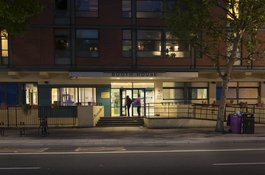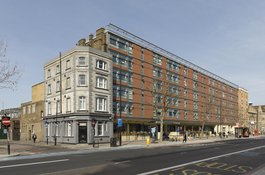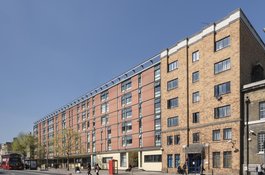Booth House
1965-7, Salvation Army hostel, refurbished and refronted 2000-2 | Part of Whitechapel workhouse and burial ground
Booth House, Salvation Army Lifehouse, 153-175 Whitechapel Road
Contributed by Survey of London on Aug. 24, 2017
From 1614 this was the site of a parish burial ground and almshouses (described elsewhere). The workhouse was replaced in 1860–2 by an imposing row of thirteen shophouses (later Nos 151–175). This four-storey speculation by John Hudson, an architect based on Leman Street, was with its Italianate stucco dressings an exceptionally unified development for Whitechapel Road.1 Only the western end survives, as 151 Whitechapel Road.
The terrace was largely vacant and ruinous in 1947, having suffered war damage. Proposals for a Salvation Army hostel on the site were put forward in 1961, the adjacent site (Victoria Home, 177 Whitechapel Road) having long since been a Salvation Army hostel. H. & H. M. Lidbetter, the Army’s usual architects, prepared plans and the building was erected in 1965–7 by Walter Lawrence & Son Ltd, and opened by Queen Elizabeth II in 1968 as Booth House Hostel, the Salvation Army’s first purpose-built hostel, named after its founder, William Booth, and said to be the largest hostel for men in London. The six-storey and basement building, with a four-storey rear wing, has a reinforced-concrete frame, originally articulated with brick-panel cladding. There were 252 cubicles, mostly single rooms, a few double, off spine corridors with communal washrooms/WCs. On the ground floor a canteen and lounge flanked the entrance foyer, with offices and the kitchen to the rear. The fourth-floor had dining, sitting, reading, TV and smoking rooms, with a sun lounge and roof garden on the rear wing.2 From early on there was a rehabilitation unit for drug addicts and alcoholics in the basement. In 1971, with most of the residents more or less permanent, accommodation for men remanded on bail was introduced into Booth House, principally to protect those not previously held in custody from others who had been. This initiative was sponsored by the Xenia Field Foundation as a social-welfare experiment to meet a ‘particular need for a bail hostel for young men who drifted into London, got into trouble of a not very serious kind, and had to be remanded in custody because there was nowhere else for them to go.’3 It helped lead to the sanction of public funding for bail hostels through the Criminal Justice Act of 1972. Alterations to the fourth floor of Booth House in 1973 formed Rawson Home, accommodation for about forty elderly residents.4
Booth House was thoroughly refurbished in 2000–2 for the Salvation Army Housing Association, Mansell PLC being the client and involving Fraser Brown MacKenna Architects. Interiors were converted to provide en-suite accommodation for 150 men, with shared kitchen/diners and tearooms on all the upper floors, the canteen continuing on the ground floor. The building was refaced with a steel-framed screen, supporting brick panels in a wholly new fenestration pattern, and the rear wing was extended and raised. The Salvation Army stopped using the term ‘hostel’, seeing it as carrying negative connotations, preferring Lifehouse. The hostel closed in 2018.5
-
Salvation Army Archives, VH/1/1: Post Office Directories ↩
-
Tower Hamlets Local History Library and Archives (hereafter THLHLA), Building Control files 15520–1: Goad map 1953 ↩
-
Home Office Research Unit Report, Frances Simon and Sheena Wilson, ‘Field Wing Bail Hostel: The First Nine Months’, 1975, p.1, seen at Salvation Army Archives COS/1/8 ↩
-
THLHLA, Building Control file 15520 ↩
-
THLHA, Building Control file 17959: The War Cry, 4 July 2015, p.13: East London Advertiser, 12 June 2018 ↩
Parish burial ground, almshouses and workhouse
Contributed by Survey of London on Aug. 24, 2017
Richard Gardiner was Whitechapel’s Rector in 1614 when parish churchwardens oversaw the acquisition of a rectangular plot of about an acre and a half of manorial common land encompassing the roadside frontage now represented by 151–179 Whitechapel Road. Seemingly in part enabled by a bequest from George Clarke (d. 1606), a Vintner, almshouses with sixteen rooms for as many widows were built on the western part of this then remote road frontage. In 1615 the rest of the site, enclosed by a brick perimeter wall, was consecrated for use by the parish of Whitechapel as an overflow burial ground called ‘the Great Church Yard at the Towns end’. By 1654 this was referred to as ‘the poors land’. A passage on the site of Davenant (formerly St Mary) Street, present by the 1660s for access to the walled garden behind, came to be called Burying- ground Court.1 A charity school was built on the east end of the burial ground in the 1680s (see 179 Whitechapel Road), yet this was still thought to be at the ‘Townsend’ in the 1730s.2
Following an enabling Act of 1763, the almshouses were replaced by a more extensive parish workhouse in 1765–8, Whitechapel’s first and smaller workhouse of 1722–4 on Alie Street having long since been found wanting. The 1760s workhouse, described as ‘a plain, modern, extensive, and commodious erection’,3 was in line with the school building that survives at No. 179 along almost the whole of the burial-ground frontage. It housed 600, making it among the country’s largest workhouses – on a par with those of St Marylebone and Liverpool; only the West End parishes of St James, with 650, and St George Hanover Square and St Martin in the Fields, each with 700, had more inmates in the 1770s.4 The adjacent school had been given leave in 1767 to take further eastern perimeter parts of the burial ground. Thus the last open ground to Whitechapel Road this far west was built over. In 1795–6, the rest of the burial ground having become the workhouse yard, the parish took a larger rectangle of what had been orchard ground immediately to the north to be a new burial ground for the poor and enclosed it with a brick wall. The workhouse was enlarged in 1812 and the western part of the new burial ground given up in 1813–15 for another school. A ‘deadhouse’ (mortuary) at the west end of the workhouse was removed to improve access to this school on what was now St Mary Street, leaving the master’s house as the corner building. The eastern part of the burial ground, extended to the rear of No. 179 in 1813, was divided off with iron railings and used for parish burials up to 1853.5
The workhouse beadle was censured in 1833 for supplying bodies for anatomical purposes, cholera having meant that 196 fatalities had been interred in the ‘workhouse garden’ adjoining to the east (behind Nos 181–185), which later became the workhouse’s stone yard. In 1838 Dr Thomas Southwood Smith’s report to the Poor Law Commissioners more generally deprecated conditions, finding that 104 girls slept in a dormitory 88ft by 16.5ft, four or five to a bed; even in the fever wards beds were shared. The Poor Law of 1834 had united the parish of Whitechapel with other districts to form the Whitechapel Union. In 1855–60 what had been Spitalfields’s workhouse, just outside Whitechapel parish to the north of Thomas Street and the Quakers’ Burial Ground on what is now the east side of Vallance Road, was rebuilt to unify and consolidate the Whitechapel Union’s workhouses. The redundant Whitechapel Road workhouse was demolished and the property sold off.6
-
London Metropolitan Archives (hereafter LMA), A/DAV/01/013, No.32; P93/MRY1/091, p.209: Tower Hamlets Local History Library and Archives (hereafer THLHLA), P/RIV/1/15/1/1–2: Royal Commission on Historical Monuments, An Inventory of the Historical Monuments in London, vol.5, East London, 1930, p.70: Roland Reynolds, The History of the Davenant Foundation Grammar School, 1966, pp.11–12 ↩
-
LMA, P93/MRY1/090 ↩
-
Wilkinson, _loc. cit._ ↩
-
Parliamentary Papers, Abstracts of the Returns made by the Overseers of the Poor, 1777, pp.85,100–1,105: Kathryn Morrison, The Workhouse, 1999, p.30 ↩
-
John Rocque's map, 1746: Richard Horwood's map, 1813: LMA, P93/MRY1/090: THLHLA, P/RIV/1/15/3/2: Wilkinson, loc. cit.: Mrs Basil (Isabella M.) Holmes, The London Burial Grounds, 1896, p.296 ↩
-
LMA, P93/MRY1/090; A/DAV/01/018; E/BN/130; SC/PM/ST/01/002: Parliamentary Papers, 1837–8 (447), XXVIII, 145, Fourth Annual Report of the Poor Law Commissioners, Appx C, pp.87–8: Holmes, loc. cit.: ed. F. H. W. Sheppard, Survey of London, vol. 27: Spitalfields, 1957, pp.285–7 ↩

Booth House, entrance in May 2018
Contributed by Derek Kendall

Booth House, 153-175 Whitechapel Road in 2016
Contributed by Derek Kendall

Booth House, 153-175 Whitechapel Road in April 2017
Contributed by Derek Kendall